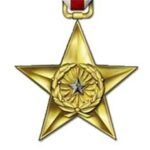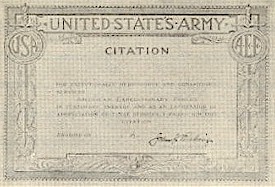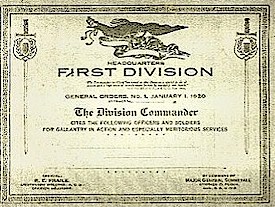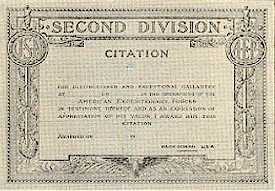Silver Star - World War I
 The Silver Star Medal is the United States' third-highest award for combat valor and ranks fifth in the importance of military awards behind the Medal of Honor, the Crosses (Distinguished Service Cross/Navy Cross/Air Force Cross), the Defense Distinguished Service Medal (awarded by the Department of Defense), and the Distinguished Service Medals of the various branches of service.
The Silver Star Medal is the United States' third-highest award for combat valor and ranks fifth in the importance of military awards behind the Medal of Honor, the Crosses (Distinguished Service Cross/Navy Cross/Air Force Cross), the Defense Distinguished Service Medal (awarded by the Department of Defense), and the Distinguished Service Medals of the various branches of service.
The Silver Star is the highest military award that is not associated with any military branch; it has been bestowed by the Army, Navy, Marine Corps, Air Force, Coast Guard, and Merchant Marines. It may be awarded by any of the individual services to not only their own service members, but to members of other service branches, foreign allies, and even civilians for "gallantry in action" in support of combat missions for the United States military.
Awards of the Silver Star Medal to heroes of World War I is an issue that is - and likely will remain - beyond resolution. The Silver Star was not established as an individual medal until July 19, 1932. At that time, veterans of World War I who had been credited for "gallantry in action" and awarded the medal was, based on specific criteria, authorized to request the issuance of the Silver Star Medal in lieu of the earlier ribbon device.
During World War I, commanders down to the company level frequently commended individual soldiers for incredible heroism in battle, distinguished service in both combat and non-combat roles, and other soldierly qualities. Only individuals cited specifically for "Gallantry in Action" were authorized to wear the 3/16" silver Citation Star on their Victory Ribbon.

The American Expeditionary Forces (A.E.F.) under the command of General John J. Pershing began citing individual soldiers, sailors, airmen, and Marines in General Orders published from 1918 to 1920, with continuing supplements through 1941. Most War Department General Orders provided citations for awards of the Medal of Honor, Distinguished Service Cross, or Distinguished Service Medal. Even so, numerous individuals were also cited personally by General Pershing for gallantry in action or for commendable conduct and were issued the A.E.F. Meritorious Service Citation.

During the same time period, commanders of the separate U.S. Army divisions cited individuals - and units - in published citations that included both combat and non-combat actions. For this reason, not all individuals were issued a citation like those shown here, or those published in the General Orders of the A.E.F.'s divisions, qualified for the Citation Star. The First Division's General Orders No. 1 (January 1, 1920), consolidated most of the previous General Orders by that division into a listing of slightly more than 14,000 members of the First Division, A.E.F., who qualified for the Citation Star.

Thus, the first challenge is in determining which World War I citations qualified for the Citation Star and, subsequently, for an upgrade to the Silver Star Medal. If the issue were as simple as simply requiring "gallantry in action" in the text, the task would be simple. But many recipients cited for distinguished conduct were subsequently determined to merit the Citation Star in those cases where their cited conduct was performed while under enemy fire. For that reason, for the purposes of our database, we will not attempt to "weed out" the conduct awards.
A second challenge is determining the multiple awards. It was entirely possible for an individual to be cited by the Brigade Commander, then cited by his Division Commander for the same action, and then perhaps cited yet again for the same action by General Pershing. An examination of the citations would indicate three awards for the same action. Furthermore, that same action might be (and in many cases was), upgraded to a Distinguished Service Cross or Silver Star.
CONVERSIONS of the SSC to the SSM
When the Silver Star Medal replaced the Silver Star Citation or Citation Star, it was up to the individual recipient to contact the War Department to request their medals. The National Personnel Records Center (NPRC) in St. Louis is said to have a file indicating which veterans requested the upgrade, although it is unclear how many names it contains. As with earlier upgrades of pre-WWI Certificates of Merit to Distinguished Service Medals or Distinguished Service Crosses, no doubt there are hundreds, if not thousands, of World War I recipients of the Citation Star who never made that application. For all intents and purposes, however, they should be numbered among the recipients of the Silver Star. For that reason, we provide our indexes and citations based upon issued General Orders, without attempting to determine which of them are actually Silver Star awards.
Listed below are links to the recipients and their citations by branch of service.

